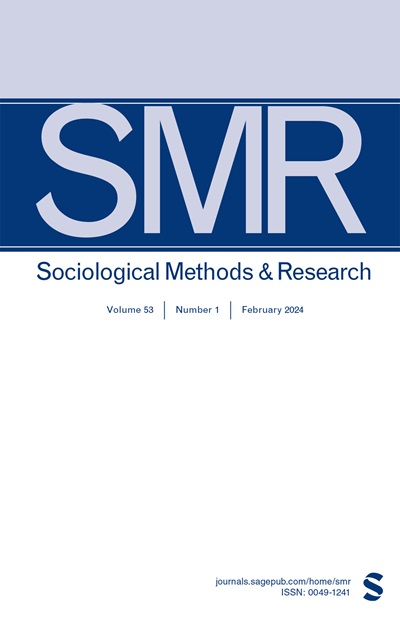Inequality of Opportunity, Income Mobility, and the Interpretation of Intergenerational Elasticities, Correlations, and Rank-Rank Slopes
IF 6.5
2区 社会学
Q1 SOCIAL SCIENCES, MATHEMATICAL METHODS
引用次数: 0
Abstract
Although there is an extensive methodological literature on the measurement of intergenerational income mobility, there has been limited research on the conceptual interpretation of mobility measures and the methodological implications of those interpretations. In this article, I focus on the three measures of mobility most frequently used in the literature—the intergenerational elasticity (IGE), the intergenerational correlation (IGC), and the rank-rank slope (RRS)—as well as a recently introduced measure, the intergenerational elasticity of expected income (IGEE). I make two main contributions, both related to the conceptual interpretation of mobility measures. First, I specify the formal relationships between those four mobility measures and the measures of inequality of opportunity developed in the luck egalitarian empirical literature on the topic, and determine the methodological implications of the analyses. I show that (a) the IGC is a measure of relative inequality of opportunity for monetary income, (b) the RRS is both a measure of relative inequality of opportunity for income rank and a rescaled measure of absolute inequality of opportunity for income rank, and (c) the products of parental income inequality by the IGEE and IGE are both measures of absolute inequality of opportunity for monetary income that differ in how they measure the value of opportunity sets. Second, relying on a conceptual distinction that has been influential in the field of public finance, the IGE and IGEE have been characterized as “person-weighted” and “dollar-weighted” elasticities, respectively, thus raising doubts about the desirability of a recent proposal to replace the IGE by the IGEE as the workhorse elasticity of the mobility field. I show that this contrasting characterization of the two intergenerational elasticities is the joint result of a category mistake—equating quantile-specific elasticities to person-specific elasticities—and of misconstruing the nature of the IGE and the epistemic goal it has been meant to serve. Based on this analysis, I conclude that the case for replacing the IGE with the IGEE remains well-founded.机会不平等、收入流动性和代际弹性、相关性和等级斜率的解释
虽然有大量关于代际收入流动性测量的方法学文献,但对流动性测量的概念解释和这些解释的方法学含义的研究有限。在本文中,我将重点介绍文献中最常用的三种流动性测量方法——代际弹性(IGE)、代际相关性(IGC)和等级-等级斜率(RRS)——以及最近引入的一种测量方法,即预期收入的代际弹性(IGEE)。我做了两个主要贡献,都与流动性措施的概念解释有关。首先,我详细说明了这四种流动性指标与运气平等主义实证文献中关于该主题的机会不平等指标之间的正式关系,并确定了分析的方法含义。我表明:(a) IGC是衡量货币收入机会相对不平等的指标,(b) RRS既是衡量收入等级机会相对不平等的指标,也是衡量收入等级机会绝对不平等的指标,(c) IGEE和IGE的父母收入不平等的产物都是衡量货币收入机会绝对不平等的指标,不同之处在于它们如何衡量机会集的价值。其次,根据在公共财政领域具有影响力的概念区分,IGE和IGEE分别被定性为“个人加权”和“美元加权”弹性,因此,最近有人提议用IGEE取代IGE,使其成为流动性领域的主要弹性,这令人怀疑。我认为,这两种代际弹性的对比特征是一个类别错误的共同结果——将分位数特异性弹性等同于个人特异性弹性——以及误解IGE的本质及其所服务的认知目标。基于这一分析,我得出结论,用IGEE替代IGE的案例仍然是有充分根据的。
本文章由计算机程序翻译,如有差异,请以英文原文为准。
求助全文
约1分钟内获得全文
求助全文
来源期刊

Sociological Methods & Research
Multiple-
CiteScore
16.30
自引率
3.20%
发文量
40
期刊介绍:
Sociological Methods & Research is a quarterly journal devoted to sociology as a cumulative empirical science. The objectives of SMR are multiple, but emphasis is placed on articles that advance the understanding of the field through systematic presentations that clarify methodological problems and assist in ordering the known facts in an area. Review articles will be published, particularly those that emphasize a critical analysis of the status of the arts, but original presentations that are broadly based and provide new research will also be published. Intrinsically, SMR is viewed as substantive journal but one that is highly focused on the assessment of the scientific status of sociology. The scope is broad and flexible, and authors are invited to correspond with the editors about the appropriateness of their articles.
 求助内容:
求助内容: 应助结果提醒方式:
应助结果提醒方式:


